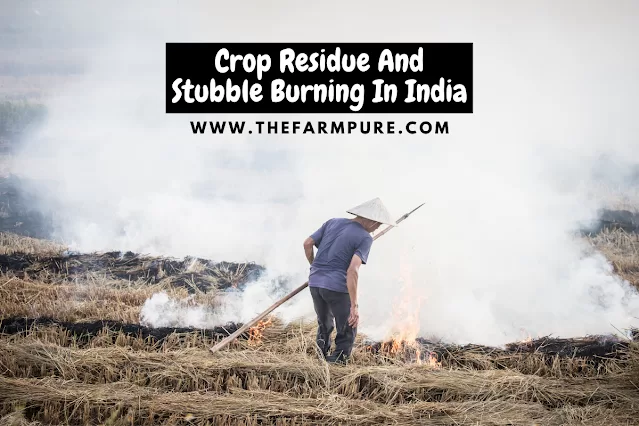India is an agrarian economy. A massive majority of the land is used For farming, and also a wide array of plants are cultivated in its different agro-ecological regions. So naturally, a tremendous quantity of crop residues is created both on-farm and off-farm. It’s estimated that approximately 500-550 Mt of crop residues are produced annually in the nation.
These crop residues are used for animal feeding, soil mulching, bio manure making, thatching for rural homes and gas for industrial and domestic use. Thus crop residues are of enormous value to the farmers. However, a sizable section of the residues is burnt on-farm primarily to wash the area to sow the succeeding crop.
On-farm burning of crop residues is intensifying recently because of lack of human labour, higher cost of removing the crop residues by traditional processes, and combining for harvesting plants. As a result, the depositions of rice, cotton, wheat, maize, millet, sugarcane, jute, rapeseed-mustard and groundnut are typically burnt on-farm across different country states. The matter is more extreme in the irrigated agriculture, especially in the mechanized rice-wheat system of this northwest India.

It’s a paradox that the burning of crop residues and shortage of fodder coexists in this country, resulting in a significant increase in grass costs in the last couple of years. On the other hand, industrial demand for crop residues is also increasing. To look after the residues productively and satisfyingly, conservation agriculture (CA) provides a fantastic promise. With the adoption of conservation agriculture-based technology, these residues may improve soil health, increase crop productivity, reduce pollution, and improve the durability and endurance of agriculture. The resource-conserving technologies (RCTs) involving minimum or no-tillage, direct seeding, bed planting and crop diversification with inventions in residues management will function as viable alternatives to conventional power and input-intensive agriculture.

Crop residue management deals with how crop residue could be changed in handy ways. For example, crop residue could be turned into a clean energy supply for agricultural cold storage after the perfect mechanisms exist. This can prove to be a possible solution to the large-scale stubble burning in Punjab and Haryana that hugely contributes to air pollution in Delhi and other parts of North India every winter.
Crop residues can improve soil structure, increase organic matter content in the soil, reduce evaporation, and help fix CO2 from the earth. Best residue management practices on agricultural lands have many positive effects on soil quality. Whatever the case, crop residues could be used in biofuel production.
Crop residue management through conservation agriculture can enhance soil productivity and crop production by preserving SOM (Soil Organic Matter) levels. Two significant benefits of surface-residue management are raised SOM close to the soil surface and improved nutrient cycling and retention. Greater microbial biomass and activity relative to the soil surface functions as a reservoir for nutrients needed in crop production and increases structural stability for more significant infiltration. Aside from the altered nutrient distribution within the soil profile, changes also occur in the physical and chemical properties of the soil. Improved soil C sequestration through improved CRM ( Crop Residue Management ) is a cost-effective alternative to minimizing agriculture’s impact on the environment.

Crop residue burning has started from the northern States, posing a threat to air quality in the area. While many measures are being attempted to reduce the burning of paddy straw and mitigate contamination, a startup incubated at the Indian Institute of Technology Delhi (IIT-D) has shown how waste biomass can be converted into valuable products such as biodegradable tableware. With a process innovated by these, three pupils have produced a demonstration unit to convert rice straw into plates and cups, which may replace today’s used plastic-lined paper plates.
Crop residue absorbs raindrop impact and keeps the wind off the ground surface. This reduces soil particle detachment, reducing erosion from the forces of wind and water. In addition, by shielding the soil surface, surface crusting can be reduced, improving infiltration and decreasing runoff.
Starting in India, Swedish home furnishing major IKEA plans to turn rice straw, a rice harvesting residue traditionally burnt and contributes heavily to air pollution, into a new renewable material source for Ikea products.
 |
| Photo credit:-Greenagri@quora |
Frequently Asked Questions (FAQs)
1. What is stubble burning?
Stubble burning is the act of removing paddy crop residue from the field to sow wheat.
2. What states are bound to do stubble burning in India?
States like Punjab and Haryana are most responsible for stubble burning.
3. What are the possible solutions to prevent stubble burning?
Speed composting can be a perfect solution. It will also enrich the soil.
4. What is mulching?
Mulching (Technically mean covering of soil) is the process or practice of covering the soil/ground to make more favourable conditions for plant growth, development and efficient crop production.
You may also like to read:-
🔬 Reviewed for Scientific Accuracy by:
Dr. Rashmi Gautam, MBBS, MD – Professor & Head, Department of Pathology
With over 15 years of academic and clinical experience, Dr. Gautam oversees the scientific and editorial integrity of educational content related to herbs, nutrition, and wellness.
ResearchGate Profile |
ORCID
Dr. Nikhil Khurana, PhD – Biochemist & Functional Nutrition Researcher
Dr. Khurana brings deep expertise in nutraceutical formulation, phytochemistry, and metabolic health. He reviews FarmPURE content to ensure alignment with evolving biochemical and plant-based research.
ORCID
All FarmPURE Blog content is reviewed by domain experts to ensure it reflects the highest standards of botanical integrity, scientific relevance, and practical guidance. Our mission is to promote better health and beauty through the power of organic herbs, spices, and plant-based wellness solutions.
Disclaimer: The information provided in this blog is intended for general wellness and educational purposes only. It is not a substitute for professional medical advice, diagnosis, or treatment. Dr. Rashmi Gautam and Dr. Nikhil Khurana participate as scientific reviewers only, and do not provide or endorse personalized medical recommendations. Always consult a qualified healthcare provider before making decisions related to your health.












